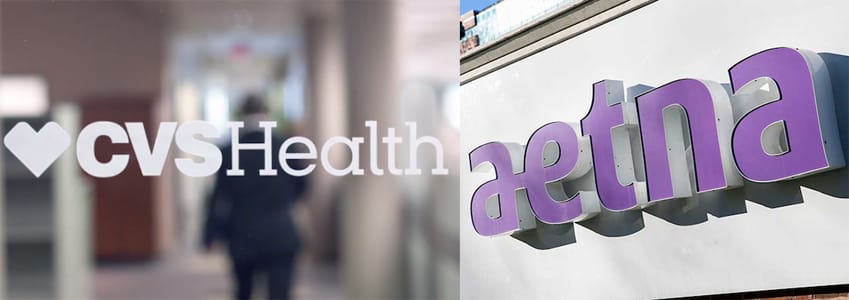
CVS Health’s announcement that it would acquire Aetna for $69 billion is only one of recent health care services deals — which totaled $72 billion in 2016 and $76 billion after the third quarter of 2017, prior to CVS announcing the final deal. Across the industry, companies are increasingly leveraging these strategic partnerships to improve patient outcomes, enhance data sharing, benefit from economies of scale and safeguard against growing competition.
Within health care, we often hear about horizontal integration, or mergers and acquisitions between organizations operating in the same space. Recent announcements of horizontal integration include Centene Corp.’s acquisition of Fidelis Care and the merger between Advocate Health Care and Aurora Health Care. As regulations change and the need for innovation rises, we hear more about vertical integration, which allows organizations to expand their operations into new areas across the health care supply chain.
CVS-Aetna is a blockbuster in vertical integration — it will combine one of the nation’s biggest health insurance companies with drug stores, clinics and prescription-distribution operations. As a result, CVS-Aetna will control more of the care delivery spectrum, enhancing its ability to improve outcomes and reduce health care costs. We expect the perceived benefits of the CVS-Aetna merger to encourage other organizations seeking integration to consider consolidating with pharmacy entities.
Pharmacy and medical benefits have historically been managed separately — the former by contracted organizations like pharmacy benefit managers and the latter by health plans. Each party uses different data sets, which can be difficult to combine due to varying data nomenclature and obstacles to linking episodes of care. PBMs track detailed pharmacy data with which they can analyze dispensing trends, medication adherence and utilization for high-risk members.

However, connecting this data to long-term medical outcomes — such as future reduction in hospital spend and visits for a chronic condition — is complex, and PBMs are largely measured on their ability to minimize costs and are not incentivized to tie their services to value. When transferring data back to the health plan, PBMs will provide detailed trend reports on pharmacy spend and utilization but rarely share more than ad hoc access to granular pharmacy data. Thus, health plans lack detailed pharmacy information, a critical component to understanding a patient’s history and overall experience with the health care system.
Assuming the deal receives federal approval, CVS-Aetna will manage both medical and pharmacy data. If the two data sets are connected and analyzed together, CVS-Aetna will have a complete set of data, including patients’ medical histories, pharmacy utilization and adherence, and certain social determinants of health. As we recently discussed, this will enable coordination between the PBM’s and health plan’s medical management teams and help the organization provide more holistic and personalized patient care. CVS has acknowledged data enhancements as a factor in its decision to merge — we expect the company to use this data to develop more widespread evidence-based best practices to help improve population health and reduce spend on acute episodes of care.
We have seen, firsthand, the difficulty health plans have gleaning actionable and proactive insights from pharmacy data. To enhance their capabilities, we have provided services scrubbing and combining the two data sets and using this information to identify previously unidentifiable correlations — such as relationships between prescribing patterns, medication adherence, emergency department utilization and inpatient admissions for pediatric asthma patients. With greater insight into root causes of high spend, utilization and outcomes, health plans are able to develop more targeted care management programs; reduce potentially preventable readmissions; improve medication adherence and care coordination; and achieve savings.
Combining pharmacy and medical benefits also offers operational benefits that are difficult to achieve on the same scale through horizontal integration. With greater control over two critical, and generally disparate, areas of the health care supply chain, CVS-Aetna can better manage supply and demand and develop efficiencies to expedite and optimize operations.
For example, the company will have greater insight into provider prescribing and member utilization behaviors, in addition to the outcomes of these activities. Using predictive analytics, CVS-Aetna can determine the highest-value, lowest-cost prescriptions for certain disease states and better manage the inventory and fulfillment of these supplies. Real-time inventory tracking will facilitate the supply chain, providing quicker access to certain prescription and other items for care. These efficiencies can benefit both the organization and the consumers — from reducing waste and costs due to more streamlined processes and improving customer loyalty and patient satisfaction due to more timely care.
Finally, the vertical merger strategically prepares CVS-Aetna for looming competition from e-commerce giants and large technology companies. Many providers and payers are concerned that they will not be able to independently compete with companies discussing entry into the health care industry — giants such as Amazon.com, Walmart and Google Inc., which have massive reach and streamlined operational capabilities.
Although CVS manages nearly a quarter of pharmacy claims in the U.S., and CVS Caremark is one of the country’s biggest PBMs, the potential market share of Amazon and convenience of its services could threaten the organization. Now that CVS will acquire Aetna’s health and engagement model, targeted wellness solutions, and provider collaboration capabilities, it stands to be a strong competitor if and when companies like Amazon enter the market. Consolidating the two organizations also has potential to result in more competitive contract rates, better prices for patients, and better outcomes that may result from any value-based contracts within the organization.
Many of the potential benefits from this merger rest on the premise that CVS-Aetna will be able to effectively connect and understand data, as well as use this data to derive insights that drive value. Without this capability, there may be risk to shareholder value and overall operations. Additionally, regardless of the ability to combine data, there is a risk that CVS may lose existing PBM contracts with some health plans if those health plans would prefer to work with a PBM that is not integrated with a competing health plan.
Despite these risks, with all of the aforementioned benefits and market and regulatory pressures likely to continue, we anticipate this merger to be one of many future partnerships to include pharmacy in consolidation efforts. New competition from CVS-Aetna will likely create a reaction among health plans and PBMs like Express Scripts and MedImpact, which have not yet merged with large insurers. If this occurs, the CVS-Aetna merger can provide valuable insights for any similar mergers and should encourage other health plans and providers to consider incorporating PBMs into their consolidation strategies.
Natalie Kish is a senior research consultant, and Maulik Bhagat is a managing director in the health care practice of AArete, a global consultancy specializing in data-informed performance improvement. They can be reached respectively at nkish@aarete.com and mbhagat@aarete.com.







